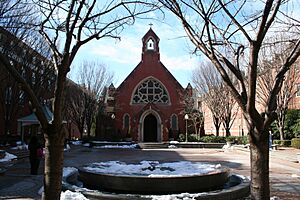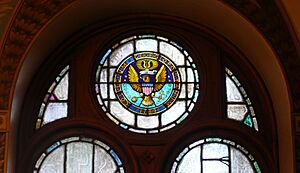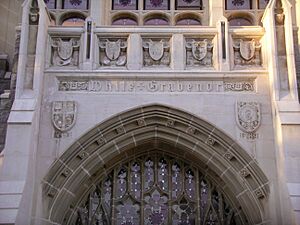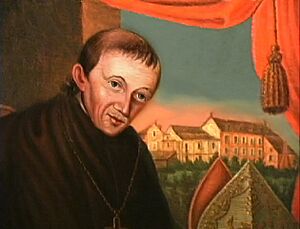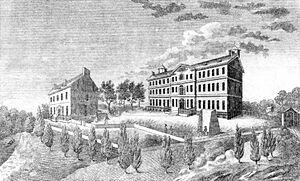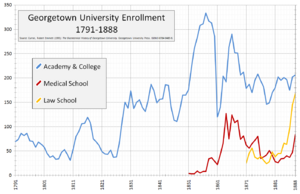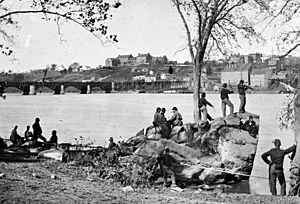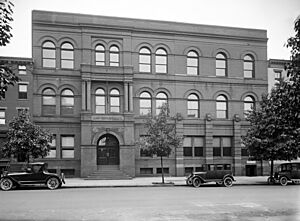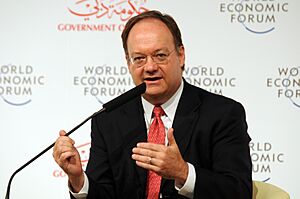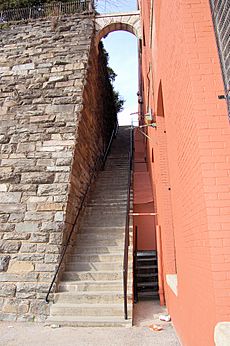History of Georgetown University facts for kids
The history of Georgetown University is a long and interesting story, stretching back nearly 400 years! This famous university has grown right alongside its city, Washington, D.C., and the United States itself. Georgetown's beginnings are found in the 1600s, when the Maryland colony was first settled. After the American Revolution allowed people to practice their religion freely, Bishop John Carroll started the school where it is today, by the Potomac River.
The Society of Jesus (also known as the Jesuits) played a big part in the school's journey. They started as founders and funders, then became teachers and advisors. Their focus on a broad education and accepting different religions helped shape Georgetown's identity. The school also went through big changes, like the American Civil War, which affected its growth and students. Later, leaders like Patrick Francis Healy helped make Georgetown a modern research university, adding more schools and chances for learning both on campus and around the world.
Contents
Founding the University
Georgetown University's history really begins with two important dates: 1634 and 1789. For a long time, the school used 1788 as its founding year, because that's when construction started on its first building, "Old South." But later, it was decided that January 23, 1789, would be the official founding date. This was the day the land for the school was officially bought.
Early Schools in Maryland
On November 22, 1633, a group of Jesuits, including Andrew White, sailed to America. They landed on March 25, 1634, which is now celebrated as Maryland Day. These Jesuits bought land from the local Yaocomico tribe and set up a missionary fort near St. Mary's City.
They wanted to start a school there. In 1640, their leader in Rome approved the idea. They moved to a permanent building, but it was burned down in 1645 during the English Civil War. The new government made their school illegal, but it was secretly running again by 1648.
Later, in 1677, the Jesuits used Newtown Manor as their schoolhouse. But in 1704, the authorities found out, and the school had to operate in secret again at Bohemia Manor. Bishop John Carroll attended this secret school from 1745 to 1748. He later joined the Jesuits and became a priest. When the Jesuit order was temporarily shut down in 1774, Carroll returned to Maryland. This put him in the right place when the American Revolution created new chances for education.
Choosing Georgetown Heights
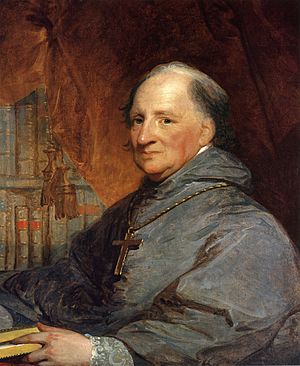
After returning to Maryland in 1774, John Carroll started a church. He also traveled to Quebec with Benjamin Franklin to try and get the French Canadians to join the American Revolution. This trip wasn't successful, but Carroll's connection with Benjamin Franklin was important. In 1784, Franklin suggested Carroll to lead the Catholic Church in America. So, on June 9, 1784, Carroll was chosen to be the head of Catholic missions in the United States. He later became the first Bishop of Baltimore in 1789.
Starting in 1783, Carroll met with other priests, many of whom were former Jesuits. In 1786, they decided that "a school be erected for the education of youth." They chose Georgetown as the location. Carroll wanted the school to be in a city, like the Jesuit colleges he had seen in Europe. By 1787, they formed a committee to raise money for an "academy, at George-town, Patowmack-River, Maryland."
Georgetown Academy Opens
In April 1787, a landowner named John Threlkeld gave a piece of land to Carroll. In April 1788, construction began on Georgetown's first building, later called "Old South." Carroll wrote that all his hopes for the Catholic religion in the United States were built on this academy. On January 23, 1789, John Carroll and others officially bought the land where construction had already started. This land became the heart of Georgetown's campus. This is why the university celebrates this date as its founding.
It was hard for Carroll to find someone to be the first president of the Academy. Finally, Robert Plunkett took the job in 1791, but he only stayed for 18 months. He divided the Academy into "college," "preparatory," and "elementary" levels. The first teacher started in October 1791, and the first student, William Gaston, enrolled on November 22, 1791. Classes began on January 2, 1792, with about 69 students.
Georgetown's second building, Old North, started being built in 1794. It was three times bigger than Old South and added many more classrooms and sleeping spaces. When it was finished, George Washington himself visited and spoke from its porch! Today, only U.S. Presidents are allowed to speak from that spot.
Early Years and Growth
In its early years, Georgetown struggled with money. It relied on private donations and small profits from local farms that had been given to the Jesuits. Some of these farms used enslaved African-American workers. By September 1792, the school had to raise its tuition fees.
In 1796, Louis William Valentine DuBourg became president. He brought many books, which started Georgetown's library. He also spent a lot of money hiring new teachers and buying things for the school, which put Georgetown in debt. The board of directors was unhappy with his spending, and he had to resign in 1798.
From 1798, Leonard Neale and his brother Francis helped the university grow. In 1799, Neale invited three sisters to open a monastery at Georgetown. This led to the Georgetown Visitation Preparatory School, a school for young women, which started in 1802.
When the Jesuit order was allowed to operate again in Maryland in 1805, several former Jesuits rejoined. John Carroll made sure that Jesuits would continue to be involved with the school.
Carroll wanted Georgetown to be officially recognized by the government. Instead of asking the state, he went to the federal government. William Gaston, a Congressman, helped pass a law that gave Georgetown its first federal university charter on March 1, 1815. President James Madison signed it into law. This allowed Georgetown to give out college degrees. The first two students received their Bachelor of Arts degrees in 1817. In 1833, the Holy See (the Pope's authority) also allowed Georgetown to give degrees in philosophy and theology.
John Carroll died in 1815 and left $400 to Georgetown, which was the start of the university's special fund. In 1830, the first hospital beds were added to Georgetown in a new building.
In 1838, the Jesuits in Maryland sold 272 enslaved people from their farms to a plantation in Louisiana. Some of the money from this sale was used to pay off debts from the college's growth. After this sale, the Maryland Jesuits stopped owning enslaved people. The money also helped start two Catholic high schools in New York City and Philadelphia.
On June 10, 1844, Congress officially renamed the school "The President and Directors of Georgetown College." Georgetown's Observatory, finished in 1844, was used to figure out the exact location of Washington, D.C. In 1850, the School of Medicine was founded, and classes started the next year.
Student Life in Early Years
From the very beginning, Georgetown was open to students of all faiths, not just Catholics. In its first ten years, almost one-fifth of the students were Protestant. Many students also came from the Caribbean, and by 1830, Jewish students were attending. Students from Europe and those escaping wars also came to Georgetown.
School rules were very strict. One president, Leonard Neale, was so strict that founder John Carroll said he ran Georgetown "on the principles of a convent." Students even rebelled against the school administration three times before the Civil War! The most famous rebellion happened in 1850 because students were unhappy with the school food.
The first student group, the Sodality of Our Lady, started in 1810 as a religious group. In 1830, the Philodemic Society was founded. It's a debating and literary club, and it's the oldest secular (non-religious) student group at Georgetown. Other debating groups were also formed. The College Cadets, a military unit, started in 1836. The Dramatic Association, which later became the Mask and Bauble Dramatic Society, started in 1852 and is the oldest student drama group in America. The first Christmas tree on campus appeared in December 1857.
The Civil War Years
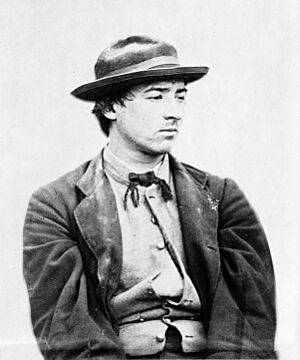
The American Civil War was a very difficult time for Georgetown University. In 1859, students in the Philodemic Society debated whether Southern states should leave the Union. This led to fights, and debates were stopped. Soon, fistfights between Northern and Southern students became common on campus.
Starting in 1861, many students left school to join the war. About 925 students fought for the Confederate Army and 216 for the Union Army. Sadly, 106 of them died. Student enrollment dropped sharply, from 313 students in 1859 to only 17 in late 1861. By 1862, Georgetown had only 120 students in total.
Because there weren't enough hospitals or places for soldiers to stay, the Union Army took over university buildings. When President Abraham Lincoln visited campus in May 1861, 1,400 Union soldiers were staying there. The university buildings were used as an infirmary (a place for sick or injured soldiers) for the rest of the war.
Georgetown was later connected to the assassination of Abraham Lincoln. Some of the people involved with John Wilkes Booth had ties to Georgetown. David Herold, who escaped with Booth, attended the school. Dr. Samuel Mudd, who set Booth's broken ankle, studied medicine there. And Charles H. Liebermann, who helped start the medical school, was one of the doctors who treated Lincoln the night he died.
After the war, Georgetown College changed a lot. More students came from Northern cities and were Catholic immigrants or their children. Before the war, most students were from the South and were Protestant. This change is shown in Georgetown's official school colors. In 1876, the rowing team chose blue (from the Union Army uniforms) and gray (from the Confederate uniforms) as their colors. This was to show peaceful unity between students from the North and the South. Georgetown's motto, Utraque Unum, means "both into one," and it perfectly captured this spirit of unity after the war.
Growing and Modernizing
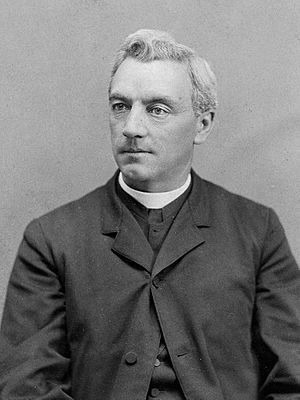
In 1874, Patrick Francis Healy became president of Georgetown University. He is known as the first African-American president of a mostly white university. Healy had a huge impact on Georgetown, so much so that he's often called the school's "second founder." He updated the school's courses, making science classes like chemistry and physics required. Healy also worked to bring the different professional schools together into one university, focusing on higher education. The most noticeable result of his time as president was the construction of a large building, started in 1877 and finished in 1881. It was later named Healy Hall in his honor.
A school of law was approved in 1870, and its first students graduated in 1872. The "Law Department" moved to new locations in 1884 and 1891. In 1870, Georgetown raised the minimum age for students at Georgetown Preparatory School from eight to twelve, and then to thirteen in 1894. As the university focused more on higher education, Georgetown Prep moved off campus in 1919 and became fully separate from the university in 1927. Georgetown Visitation Preparatory School, however, has remained close to the university campus.
Many new schools were started in the 1900s. The School of Foreign Service (SFS) was founded in 1919 to prepare students for leadership in international business and diplomacy. After World War I, the U.S. Army created the ROTC, and Georgetown's student military unit became the Hoya Battalion. The Institute of Languages and Linguistics started in 1949, and the School of Business was created from the SFS in 1957.
New things also happened at the School of Medicine. In 1898, Georgetown University Hospital was built on campus. Georgetown also took over the Washington Dental College in 1901 and combined it with the medical school. In 1903, Georgetown University started an undergraduate medical program with the School of Nursing. A new Medical-Dental Building was finished in 1930, moving classes to the main campus. In 1951, the School of Dentistry became its own separate school within Georgetown University.
On October 4, 1966, Congress passed a law that officially recognized the school's name as "Georgetown University" for the first time. Before that, the law only called it "Georgetown College," which was just one part of the university. In 1970, Lauinger Library was also completed, providing much-needed space for the growing library collection. In 1971, the law school moved to its current location.
Reaching Across Borders
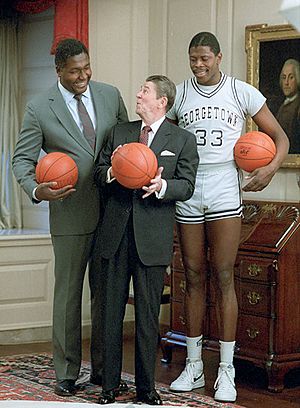
The 1950s and 60s brought big changes to Georgetown's leadership and student body. Female students had been allowed in the School of Medicine since 1880, the School of Nursing since it started, the Graduate School since 1943, and the School of Foreign Service since 1944. While most of the university was open to women in a limited way by 1952, it wasn't until the College of Arts and Sciences welcomed its first female students in 1969 that Georgetown became fully coeducational (meaning both male and female students).
President Lawrence C. Gorman ended racial segregation at the university. Samuel Halsey Jr. became the first Black undergraduate student in 1950. The Black Student Alliance was formed in 1968.
Modern Georgetown is largely shaped by major changes in the 1980s. In 1982, the School of Foreign Service moved into its new home. The 1984 NCAA Men's Division I Basketball Tournament championship won by Georgetown's men's basketball team made Georgetown University a famous name. Stars like Patrick Ewing and Dikembe Mutombo played under Coach John Thompson.
In 1989, Leo J. O'Donovan became president. He started a big fundraising effort called the Third Century Campaign. In December 2003, Georgetown finished this campaign, raising over $1 billion! This money helped with student financial aid, new academic positions, and new building projects.
In 1987, the university decided to close the School of Dentistry after the class of 1990 due to financial reasons. In 1994, the School of Languages and Linguistics became part of the college. In 1998, the School of Business was renamed the McDonough School of Business. In 2009, it moved into a new building. In 1999, the School of Nursing added other health-related majors and changed its name to the School of Nursing and Health Studies.
John J. DeGioia, Georgetown's first president who is not a priest, has led the school since 2001. He has continued to improve the university's finances and has worked to "expand opportunities for intercultural and interreligious dialogue." In 2002, Georgetown started looking into opening a campus of the Edmund A. Walsh School of Foreign Service in Qatar. The School of Foreign Service in Qatar opened in 2005. That same year, Georgetown began a workshop at Fudan University in Shanghai, China, which later led to a more formal connection.
DeGioia also started the annual Building Bridges Seminar in 2001, which brings religious leaders from around the world together. This is part of Georgetown's effort to promote religious acceptance. Several centers have also been opened to encourage understanding between different cultures and religions, such as the Center for Contemporary Arab Studies (1975), the Prince Alwaleed Center for Muslim–Christian Understanding (1993), and the Berkley Center for Religion, Peace, and World Affairs (2004).
Georgetown in Movies and TV
Georgetown, as a well-known university, has appeared in many movies and TV shows over the years. A famous example is the 1971 horror novel, The Exorcist, written by William Peter Blatty, who graduated from Georgetown. The book is based on real events that happened near Georgetown University Hospital. In 1973, Blatty's book was made into a movie, also called The Exorcist. The movie was set at Georgetown and filmed on campus in 1972. The famous climactic scene uses a steep staircase near campus, now known as the "Exorcist steps."
The 1985 movie St. Elmo's Fire was about a group of students who had just graduated from Georgetown. The bar in the movie is based on The Tombs, a popular bar and restaurant near Georgetown's front gates. Georgetown didn't allow filming on campus for this movie, so some parts were shot at the nearby University of Maryland.
Georgetown University has also been a setting or destination for characters in other films like Above the Rim, Save the Last Dance, Election, and The Girl Next Door. It has also appeared in TV shows such as The Sopranos and The West Wing, which filmed scenes on campus. The movie Memento was written by Jonathan Nolan, a Georgetown graduate.
|
See also
- Georgetown Preparatory School
- History of Washington, D.C.
- List of presidents of Georgetown University
- List of Georgetown University alumni
- 1838 Jesuit slave sale


